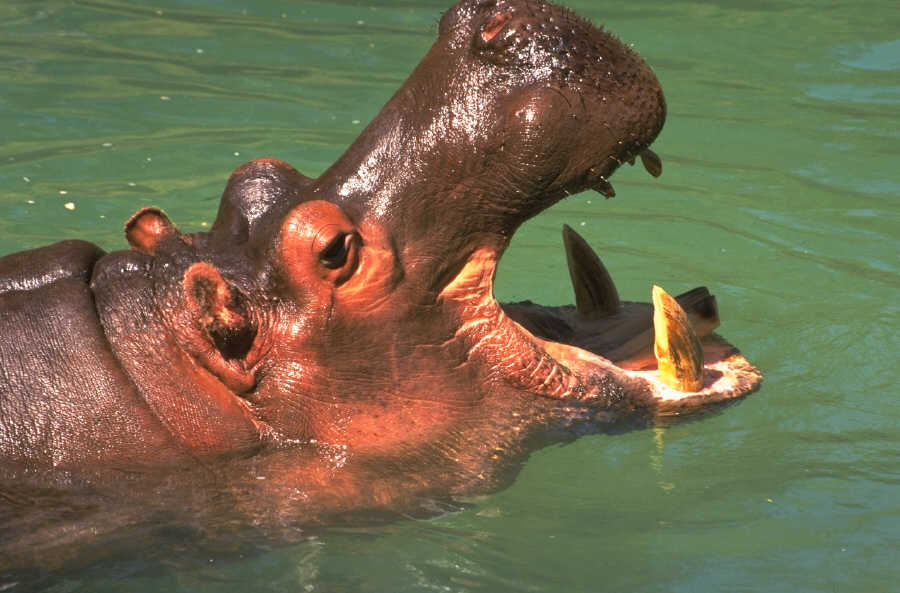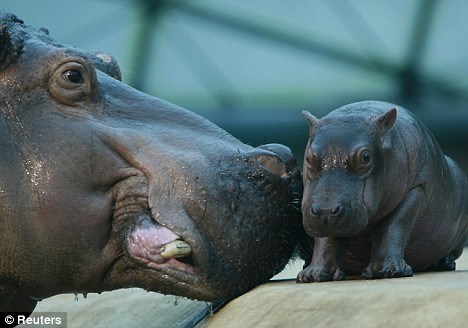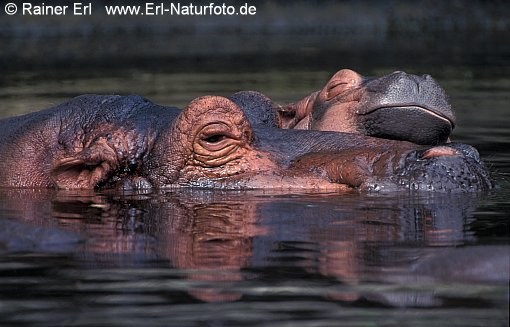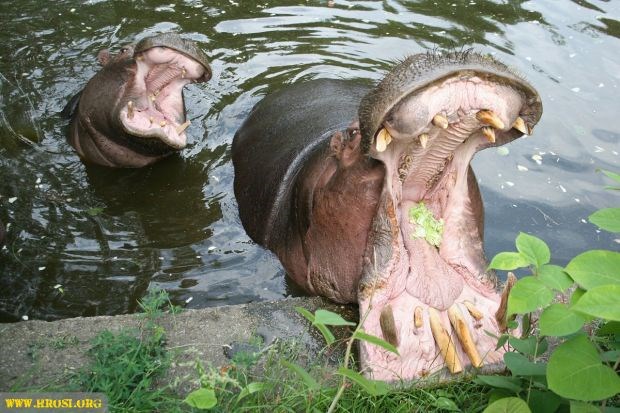
CZ
Hroch obojzivelny (Hippopotamus amphibius)
rad - sudokopytnici (Artiodactyla)
celed - hrochoviti (Hippopotamidae)
Zakladni informace
Hroch má zavalité tělo s velkou hlavou s široce rozevíratelnou tlamou. Má krátké, sloupovité nohy se čtyřmi prsty, krajní dva prsty má dobře vyvinuty a při chůzi došlapuje na všechny prsty. Mezi prsty má krátkou plovací blánu. Protože tráví většinu času ve vodě (zhruba 18 hodin denně) má uzavíratelné ušní boltce a nozdry.
Na hrochovi jsou velmi nápadné zuby (vzorec: 2 1 4 3 / 2 1 4 3), kterých má 40. Nejvýraznější jsou stále dorůstající špičáky, které s kořeny mohou měřit až 70 cm, při váze 4 kg. Hroší špičáky, na rozdíl od slonoviny nežloutnou, proto se využívaly k výrobě zubních protéz.
Hroší kůže je velmi citlivá na sluneční záření, proto vylučuje načervenalý mazlavý sliz, který pohlcuje UV záření a zároveň zabraňuje šíření bakteriální infekce. Díky červené barvě tohoto slizu se říká, že hroši potí krev. Při vyschnutí dosahuje hroší kůže extrémní tvrdosti, proto se dříve využívala k broušení diamantů.
Hroši jsou vegetariáni, živí se převážně vodními rostlinami, které jsou pro ostatní býložravce nestravitelné. To jim umožňuje speciální konstrukce žaludku, který je rozdělen na tři velké části a jedenáct menších částí, další zvláštností je i na býložravce dlouhé střevo (50 - 60 m). V noci spásají porost na březích, během jedné noci hroch ujde zhruba 10 km a sežere zhruba 40 - 60 kg potravy, což je při jeho váze relativně malé množství. Jeho „zívání“ je vypouštění přebytečných plynů vznikajících při trávení rostlinné potravy v žaludku.
Přestože se hroch nejraději pohybuje ve vodě zhruba metr hluboké, tak že mu vykukují pouze oči a nozdry a působí nemotorně, dokáže výborně plavat (uplave až 30 km), je schopen se potopit na 5 minut v extrémním případě se může potopit až na deset minut. Na souši se hroch také dovede pohybovat poměrně rychle (až 30 km/h).
Velikost se standardně udává do 460 cm, výška v kohoutku pak do 150 cm, váha samce se pohybuje mezi 1500 a 3200 kg, samice váží do 1500 kg, délka ocasu 35 - 50 cm. Hroši se v zajetí dožívají zhruba 45 let, nejstarší známý hroch se dožil 59 let.

Zpusob zivota
Hroši jsou teritoriální zvířata, žijící ve stádech, která mají zpravidla 15 - 20 kusů, výjimečně i výrazně více. Vůdcem stáda je dominantní samec. Ve stádu výrazně převládají samice, kterých zpravidla bývá kolem 75%. Mladší samci se zpravidla zdržují v malých skupinách v dostatečné vzdálenosti od dominantního samce, v případě že se setkají, plazí se po břiše, čímž dávají najevo své podřadné postavení. Své teritorium vyznačují trusem, který ocasem roztrušují po kmenech stromů a kamenech.
Dominantní samec bývá starý přes dvacet let a své postavení většinou udrží zhruba deset let. O dominanci svádí hroši souboje, které často končí zraněními, zřídka i smrtí. Souboj se zpravidla odehrává ve vodě, začíná zastrašováním dlouhými kly a hlasitým řvaním, pokračuje snahou kousnout a podupat soupeře. V případě setkání dvou rovnocenných soupeřů, může souboj trvat i několik hodin. V případě setkání dvou dominantních samců, k tomu dochází pouze na hranici teritoria, se k sobě obrátí zadky, vydefekují se a ocasem rozmetají své výkaly, k souboji mezi nimi dochází ve zcela ojedinělých případech.
Hroch obojživelný je považován za jedno z nejnebezpečnějších afrických zvířat. Samci, nebo samice s mláďaty jsou velmi agresivní a bez varování útočí prakticky na jakéhokoliv vetřelce v jejich teritoriu.
Hrosi v ZOO Praha
30. 10. 1984 se narodil poslední potomek páru Zulu - Zaira, samec Slávek. Ten přežil i ničivou povodeň v roce 2002 a žije v zoo dodnes. Od současných hrochů je snadno rozpoznatelný, protože je největší.
13. 08. 2002 přišla zmíněná ničivá povodeň, při které se utpoila Barborka; její matka musela být zastřelena. Jediný Slávek přežil nahoře v pavilónu slonů a dva dny čekal na vysvobození. Potom byl provizorně přemístěn do výběhu nosorožců.
Aby nebyl sám, dostal Slávek 15. 11. 2002 novou partnerku - hrošici Marušku, narozenou 29. 12. 1999 v Ostravě. Ta s ním žije dodnes. Poznáte ji tak, že je daleko menší, než Slávek, má také růžovou skrvnku zespoda na krku a na levém boku u zadních nohou a bílé prsty na pravé přední noze.
Prvními mláďaty Marušky byli dva samečci. O prvního z nich, narozeného 08. 11. 2004, se Maruška prý neuměla postarat a uhynul důsledkem traumatu po šarvátce se Slávkem ještě ten samý den. O druhého, narozeného 09. 07. 2005, se naopak starala až moc, zemřel 11. 07. 2005. Až třetí pokus vyšel - 21. 04. 2006 se narodil další sameček, který byl pokřtěn na jméno Tomík. 23. 06. 2010 odjel do francouzské Zoo du Bassin D'Arcachon, kam o den později dorazil.
Zatím poslední mládě v zoo se narodilo 08. 06. 2011. Je to samec a 21. 08. 2011 dostal jméno Váleček (pokřtěn Markem Ebenem).
Neco o kesi
Kes je velikosti small, nachazi na relativne frekventovanem miste, proto doporucujeme odlov v rannich hodinach nebo tesne pred zaviraci dobou ZOO. Pri odlovu se divejte kolem sebe na vsechny strany. Budeme radi, kdyz k logu prilozite zajimavou fotku hrochu.

EN
The Hippopotamus (Hippopotamus amphibius)
order - Artiodactyla
family -Hippopotamidae
Basic characteristics
The hippopotamus is semi-aquatic, inhabiting rivers, lakes and mangrove swamps, where territorial bulls preside over a stretch of river and groups of 5 to 30 females and young. During the day they remain cool by staying in the water or mud; reproduction and childbirth both occur in water. They emerge at dusk to graze on grass. While hippopotamuses rest near each other in the water, grazing is a solitary activity and hippos are not territorial on land.
Despite their physical resemblance to pigs and other terrestrial even-toed ungulates, their closest living relatives are cetaceans (whales, porpoises, etc.) from which they diverged about 55 million years ago. The common ancestor of whales and hippos split from other even-toed ungulates around 60 million years ago. The earliest known hippopotamus fossils, belonging to the genus Kenyapotamus in Africa, date to around 16 million years ago.
The hippopotamus is recognizable by its barrel-shaped torso, enormous mouth and teeth, nearly hairless body, stubby legs and tremendous size. It is the third largest land mammal by weight (between 1½ and 3 tonnes), behind the white rhinoceros (1½ to 3½ tonnes) and the three species of elephant (3 to 9 tonnes). The hippopotamus is one of the largest quadrupeds (four legged mammals) and despite its stocky shape and short legs, it can easily outrun a human. Hippos have been clocked at 30 km/h (19 mph) over short distances. The hippopotamus is one of the most aggressive creatures in the world and is often regarded as one of the most dangerous animals in Africa. There are an estimated 125,000 to 150,000 hippos throughout Sub-Saharan Africa; Zambia (40,000) and Tanzania (20,000–30,000) possess the largest populations. They are still threatened by habitat loss and poaching for their meat and ivory canine teeth.

Behavior
Hippos spend most of their days wallowing in the water or the mud, with the other members of their pod. The water serves to keep their body temperature down, and to keep their skin from drying out. With the exception of eating, most of hippopotamuses' lives — from childbirth, fighting with other hippos, to reproduction — occur in the water.
Hippos leave the water at dusk and travel inland, sometimes up to 8 kilometers (5 mi), to graze on short grass, their main source of food. They spend four to five hours grazing and can consume 68 kilograms (150 lb) of grass each night. Like almost any herbivore, they will consume many other plants if presented with them, but their diet in nature consists almost entirely of grass, with only minimal consumption of aquatic plants. Hippos have (rarely) been filmed eating carrion, usually close to the water. There are other reports of meat-eating, and even cannibalism and predation. The stomach anatomy of a hippo is not suited to carnivory, and meat-eating is likely caused by aberrant behavior or nutritional stress.
The diet of hippos consists mostly of terrestrial grasses, even though they spend most of their time in the water. Most of their defecation occurs in the water, creating allochthonous deposits of organic matter along the river beds. These deposits have an unclear ecological function. Because of their size and their habit of taking the same paths to feed, hippos can have a significant impact on the land they walk across, both by keeping the land clear of vegetation and depressing the ground. Over prolonged periods hippos can divert the paths of swamps and channels.
Adult hippos move at speeds up to 8 km/h (5 mph) in water. Adult hippos typically resurface to breathe every three to five minutes. The young have to breathe every two to three minutes. The process of surfacing and breathing is automatic, and even a hippo sleeping underwater will rise and breathe without waking. A hippo closes its nostrils when it submerges.
As with fish and turtles on a coral reef, hippo occasionally visit cleaning stations and signal by wide-open mouth their readiness for being cleaned of parasites by certain species of fish. This situation is an example of mutualism in which the hippo benefits from the cleansing while the fish receive food.
Hippos in Prague ZOO
30. 10. 1984 was born a male, Slávek. He survived the devastational flood in 2002 and lives in ZOO until now. You can easily recognize him, because he is the biggest.
13. 08. 2002 came the flood, one hippo died, the other has to be shot, the only survivor was Slavek, becasue he was hidden up in Elephant area, but waited 2 days until he was finally rescued. Thne he temporary lived in rhino area.
On 15. 11. 2002 got Slavek his female partner -Maruska, born on 29. 12. 1999 in Ostrava. They still live together. You can recognize her, she is smaller and has a small pink spot on her neck and hip and white toes on right front foot.
At first they had 2 baby animals - boys. First died on trauma with Slavek and second died too despite intensive care of Maruska. Third attempt - 21. 04. 2006 was born next baby boy - Tomík. 23. 06. 2010 arraved at french Zoo du Bassin D'Arcachon
The last baby boy was born on 08. 06. 2011. On 21. 08. 2011 was named Váleček (by known czech moderator Marek Ebenem).
About the cache
It is a small container. It is placed on quite frequent spot with plenty of muggles, that's the reason why we recommend to hunt it in the morning or around closing time of the ZOO. Check all sites when youa re hunting! We appreciate some interesting pictures of hippos in the logs.